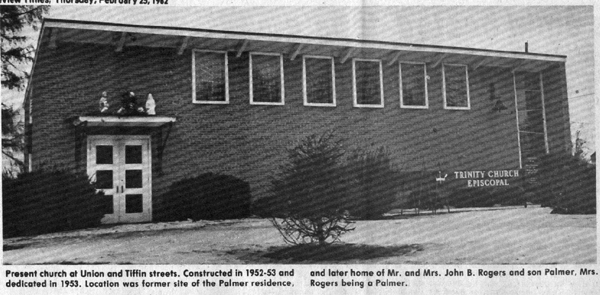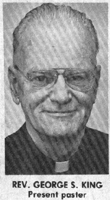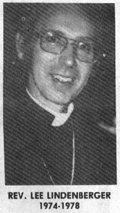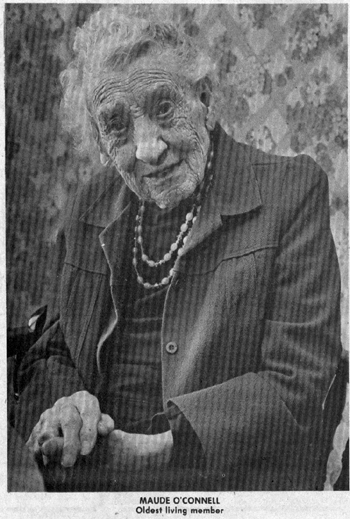February 25, 1982




Picture #2 – Rev. George S. King Present Pastor
Picture #3 – Rev. Lee Lindenberger 1974-1978
Picture #4 – Maude O’Connell
Further discouragement came to Trinity at the time the underpass and highway program for Fostoria was underway. As it turned out, Trinity’s church building at South and Wood streets sat in the path of the new highway construction.
Services were held in the old church at South and Wood streets until April 12, 1951, and shortly thereafter it was demolished. Thereafter, the congregation used facilities at the YMCA for regular services until a new location for the church could be decided.
Later, the Palmer property at Tiffin and Union streets was chosen as the new site for the church at a cost of $12,000, and that amount with the $30,000 which the State of Ohio paid as damages, allowed the congregation to proceed to build a new church.
The old brick Palmer house which had stood there for many years was demolished. While the new church was being constructed, the congregation used the old carriage house which stood on the rear of the Palmer property for their sanctuary and meeting place.
DEDICATION DREW NOTABLES
Whereas the old church was built around the classical medieval type architecture, with an attempt to capture that style in wood, the new church was modern in design. Dedication ceremonies were held in September 1953, with clergy from all over Ohio and as far away as New York present.
Vestry members who were active during the building of the new church were: Griswold B. Werner, Harold W. Worley, C.W. Mottram, Allen Simmons, N.M. Albertson, Herbert J. Ash, W. Belshaw, C.A. Blackburn Jr., J.V. Bovee, E.R. Burdick, A.H. Raymont, G.N. Stahl.
This story would not be complete with mentioning some of those who contributed so greatly, and served so faithfully during the early life of the church. Many names and faces were refreshed in your author’s memory as he went through the old Trinity record books, seeking data for this article.
OLDEST CHURCH MEMBER
The O’Connell family, specifically Maude, is one of those. That family was one of nearly 150 who had joined Trinity church in the period between 1890 and 1907. Maude is the only one of her family still living. She may even be the oldest living person to have joined Trinity.
I talked to her the day the accompanying picture was taken at the Edgewood Manor where she had resided for the last few years. Prior to that, she lived at 120 W. Lytle St., the family home for many years, and the address which is registered in the first church record book. It was good to see “Maudie” that day since we both worked at Fostoria Industries back when it was Fostoria Pressed Steel.
All of the O’Connell family is listed in the church’s first volume of records, starting back in 1890. The entry for their family was Jane, the mother, age 49; son Edward, age 16; Fanny, daughter, age 12; Maude, daughter, age 11; Gertrude, daughter, age 8.
The day “Maudie” and I talked, the first in years, I found a very alert 97-year-old “young” lady. She’s not quite as spry as she once was, and her hearing is impaired some, but we had no real problem in conversing. She knew me at once when Augusta Wolf, one of her close friends ushered me into her presence. And as we talked she recalled names and faces easily.
BROTHER EARLY MEMBER
She told me that brother Edward, five years her senior, had started going to the church before it was organized, and when services were being held in the Bond Block on South Main Street.
The Hoeges and Butterfields were two families she recalled quickly when I asked her about early leaders in the church. She remembers Rev. Sidenour, Rev. Ottman and Rev. MacIlwain from a period when she was one of the young people active in the church.
For many years “Maudie” was a Sunday school leader, working along with Helen Hoege, Mildred Miller and Carmen Ash; and in later years with Fran Matz, Pat Walker, August Wolf and Cindy (Wolf) Fuller.
When the new church at Tiffin and Union streets was completed, “Maudie” furnished one of the stained glass windows in memory of her family.
Ralph and Mildred Cummings also donated a stained glass window for the new church; and still another was installed in the memory of Dr. George L. Hoege, who had worked diligently to help establish Trinity, and continued faithfully until his passing.
JUNK BOUGHT ORGAN
Another worthwhile item which needs to be mentioned pertains to the devotion of another Trinity member when the church was built…Mrs. Anna Stahl, who at that time lived at 162 E. Fremont St. The story which was printed at the time, I now retell. Mrs. Stahl didn’t want to see the old, outmoded organ used in the first church transplanted in the new one.
Single-handed, she took upon herself the take of raising $2,035 for a new organ. Her method for raising money was the collection and sale of newspapers and salvageable materials. It was a sizable sum to raise by that method, but her conviction and hard work accomplished the job.
PROMINENT IN CHURCH
There are many names I recognized in pursuing the old church records, some of whom were prominent in business and industry and city affairs. Here are a few of them: Dewey St. John and Andrew Mergenthaler of The First National Bank, along with their families; Mr. W.H. Whitta, once mayor, and his family; Charles Foster, once governor, and family; Harry L. Porter, drycleaner and family; C.A. Ward, musician and family; Harry E. Bradner, businessman and family; Beverly Campbell, druggist; Ida McDermott, educator; Charles Miniger, businessman and wife; Herbert and Josephine Ash; Asa and Jay Mann (brothers), morticians; Charles Ash, banker and family; Ash Lyons and family; Richard Edison, businessman and family; Isaac Harter, industrialist and family; Clyde Hull, postmaster and family, and many other families who filled a niche in the community, such as Hitchcocks, Killeys, Hatchets, Werners, Overtons, Champions, Germans, Reeves, McNeils, Knox, Portz, Shiflets, Worleys, Matz, Stollenmeyer, Slaymakers, Lehmanns, McConnells, Wolfs, Mottroms, Walkers, Williams, Trumplers, and the list could go on and on.
As I bring this article to a close, I remember the earlier statement, in which the Ohio Bishop, during the early days of Trinity referred to it as “the most discouraging place in the Diocese.” I pondered on that remark as I continued to write this article, trying to find the answer as to why Trinity has prevailed with so many “ups and downs.” Most churches have them. Some churches split apart and form new ones. Others merge to form new denominations. Some just quit. But, Trinity has prevailed despite discouraging circumstances.
There are several reasons which probably answer the question. First of all, according to Rev. George S. King, the current priest in charge, there have always been a few women…not men, who held things together, when problems arose. Second, there have been times when the Diocese has responded to local dilemmas and helped overcome problems, whether they were financial or otherwise. Third, the laws of the Protestant Episcopal Church were designed to generate loyalty and obstruct individuals from organizing new churches within the denomination framework.
And finally, your author must add a personal opinion which comes from reading the old church records and talking with Rev. King: I have sensed a deep loyalty on the part of those clergy who have served here, some of whom have been paid on a part time basis, gaining their support from other employment.
HEED GOD’S WORD
“Where little has been given, little love is shown.” (Luke 7:48). That quotation was Jesus speaking to Simon, a Pharisee, where he (Jesus) had been invited to dinner.
An immoral woman, learning Jesus was there, came into the house. She weeped because of her immorality and the tears wet Jesus’ feet. She wiped the tears from his feet with her hair and kissed them, then she applied expensive myrrh.
Simon thought, and said, that Jesus should not have allowed the woman to so demonstrate because she was a sinner, and that Jesus being a “prophet” should have known that.
Jesus replied to Simon with a parable…”Two men were in debt to a money-lender; one owed five pieces of silver, the other fifty. As neither had anything to pay he let them both off. Now which will love him most?” Simon admitted the one with the greatest debt.
The greater the sin (debt), when the sinner has repented, the greater will be his appreciation and love for the Lord.